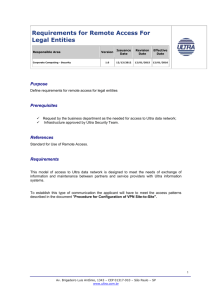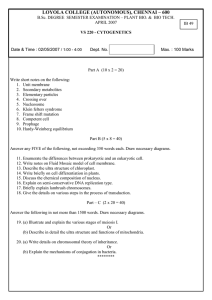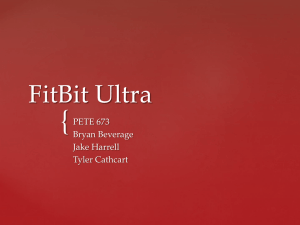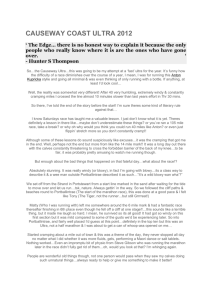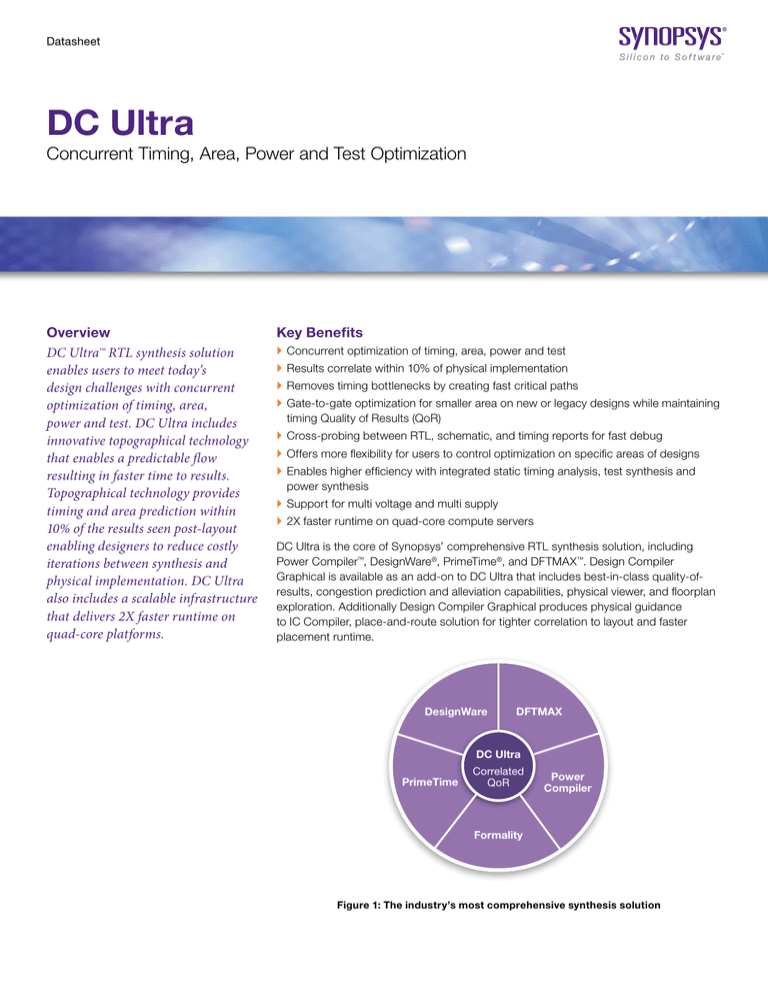
Datasheet
DC Ultra
Concurrent Timing, Area, Power and Test Optimization
Overview
DC Ultra™ RTL synthesis solution
enables users to meet today’s
design challenges with concurrent
optimization of timing, area,
power and test. DC Ultra includes
innovative topographical technology
that enables a predictable flow
resulting in faster time to results.
Topographical technology provides
timing and area prediction within
10% of the results seen post-layout
enabling designers to reduce costly
iterations between synthesis and
physical implementation. DC Ultra
also includes a scalable infrastructure
that delivers 2X faster runtime on
quad-core platforms.
Key Benefits
``
Concurrent optimization of timing, area, power and test
``
Results correlate within 10% of physical implementation
``
Removes timing bottlenecks by creating fast critical paths
``
Gate-to-gate optimization for smaller area on new or legacy designs while maintaining
timing Quality of Results (QoR)
``
Cross-probing between RTL, schematic, and timing reports for fast debug
``
Offers more flexibility for users to control optimization on specific areas of designs
``
Enables higher efficiency with integrated static timing analysis, test synthesis and
power synthesis
``
Support for multi voltage and multi supply
``
2X faster runtime on quad-core compute servers
DC Ultra is the core of Synopsys’ comprehensive RTL synthesis solution, including
Power Compiler™, DesignWare®, PrimeTime®, and DFTMAX™. Design Compiler
Graphical is available as an add-on to DC Ultra that includes best-in-class quality-ofresults, congestion prediction and alleviation capabilities, physical viewer, and floorplan
exploration. Additionally Design Compiler Graphical produces physical guidance
to IC Compiler, place-and-route solution for tighter correlation to layout and faster
placement runtime.
DesignWare
DFTMAX
DC Ultra
PrimeTime
Correlated
QoR
Power
Compiler
Formality
Figure 1: The industry’s most comprehensive synthesis solution
Topographical Technology
Topographical technology delivers tight
correlation to post-layout timing, area, test
and power without the need for wireload
models. It is designed for RTL designers
and requires no physical design expertise
or changes to the synthesis use model
(Figure 2). Prediction of layout timing and
area in DC Ultra is achieved through the
innovative topographical technology.
It enables RTL designers to fix real
design issues while still in synthesis and
generate a better starting point for place
and route, eliminating costly iterations.
This significantly boosts RTL designers’
productivity. Topographical technology
shares technology with Galaxy™
implementation, minimizing iterations to
speed up physical implementation.
WLM
No need for wireload
models
Correlates to postlayout timing area,
and power
No change to
synthesis use model
DC Ultra
Topographical
technology
Physical
library
Built
B
ilt ffor RTL d
designers
i
Figure 2: Topographical technology in RTL synthesis
Area Reduction Technologies
DC Ultra provides optimization technologies
that monotonically reduce gate-to-gate area
by an average of 10% while maintaining
Quality of Results (QoR). These advanced
optimizations operate on both new and
legacy design netlists, with or without
physical information and at all process
nodes. Area reductions are achieved
without re-synthesis and without affecting
timing results for maximum productivity.
Figure 3: Cross-probing between RTL, schematic and timing view
a
Cross-Probing
Cross-probing between the RTL source
code and other design views such as
schematic, timing reports and physical
implementation provide designers with the
ability to quickly detect potential design
issues and fix them at the source. Early
visibility into potential design issues using
multiple views accelerates the creation of
high quality RTL and constraints.
b
c
*
d
e
f
*
DC Ultra
b
c
Mul
T2
+
+
Carry delay
incurred 3x
d
∑
z
z<=a*b+c*d-e-f
Carry delay
incurred 3x
e
f
Mul
T2
∑
C
Cin
∑
CSA
transformation
Advanced Arithmetic
Optimization
For designs containing datapath, DC Ultra
uses innovative datapath optimization
algorithms to achieve better qualityof results in terms of timing, area and
power with fast runtimes. DC Ultra
identifies arithmetic trees in your HDL and
optimizes them using carrysave arithmetic
techniques to minimize performance and
area impact of carry propagation (Figure
a
C
Cin
Cin
C
∑
Cin
C
+
Cin
C
z
Figure 4: Transformation of sum of products into a Carry Save Adder (CSA) tree
4). With DC Ultra, logic synthesis users
can also take advantage of superior
datapath synthesis capability to generate
highly optimized implementations of
DesignWare arithmetic components.
2
Powerful Critical Path
Synthesis
DC Ultra employs various optimization
algorithms throughout the synthesis
process to deliver ultra-fast critical path
timing. For example, immediately after the
initial technology mapping, the design is
not yet subjected to detailed gate-level
optimization techniques. At this stage, DC
Ultra performs aggressive timing driven
restructuring, mapping and gate-level
optimization. As a result, the subsequent
detailed gate-level optimizations benefit
from better overall timing-based structure.
Throughout gate-level optimization,
additional strategies are applied to
improve the delay of the critical paths
in the design. One of the techniques
includes aggressive logic duplication for
reducing the load seen by the critical
path (Figure 5). DC Ultra looks at a larger
subsection of the critical path during
logic duplication and can replicate many
gates to reduce load of high fan-out nets,
hence improving timing on critical paths
through load isolation. DC Ultra will also
automatically ungroup parts of the design
on the critical path to achieve better area
and timing. It can also buffer high fan-out
nets to improve total negative slack.
The DC Ultra mapping algorithms also
attempt to map groups of cells to wide
fan-in library cells on critical timing paths
that can reduce number of logic levels
and cell instances. Thus, timing, area, and
power are improved.
A
logic
Before
B
critical
logic´
critical
After
A
logic´´
B
Figure 5: Through logic duplication, DC Ultra reduces the load on the critical path for
significant timing improvements
Existing circuit
7.5
10.2
Circuit after
clock
period = 10
8.2
9.8
Inputs
Outputs
Figure 6: Retiming designs with registers
Existing circuit
Circuit after
Register Retiming
Register retiming further improves QoR.
It performs optimization of sequential
logic by moving registers through logic
boundaries to optimize timing with
minimum area impact (Figure 6) for
designs that already contain registers.
The same functionality is preserved
at I/O boundaries. Register retiming
can also insert pipeline registers in
pure combination circuits to be used
to meet performance requirements as
well as reduce area (Figure 7). Register
retiming can be used along with datapath
optimization algorithms to get the
fastest pipelines.
DC Ultra
23.0
10 ns
Inputs
Outputs
8.9
4.0
Inputs
7.3
Outputs
Figure 7: Retiming on combinational logic
3
Better Control of Synthesis
Cost-Function Priorities and
Optimization Steps
DC Ultra provides finer control over
optimization to meet aggressive timing
requirements. DC Ultra has a default
cost function that prioritizes design
rule requirements over timing and area
constraints. By setting the appropriate
priority, designers can drive synthesis
to achieve the best QoR for a design.
Compile directives in DC Ultra can be
used to further control optimization. The
compile directives allow the designer to
change DC Ultra’s standard behavior. For
example, a designer may have a particular
structure in mind and have instantiated
the cells in the path. Although the overall
structure should not change, it may be
desirable for Design Compiler to perform
sizing and local optimization for better
timing. For this set of optimizations, the
global structuring of the logic can be
disabled while enabling gate sizing.
2X Faster runtime on 4 cores
20
Single core runtime
16
Multicore runtime
14
8
4
0
350k
368k
473k
The advent of multicore processors in
computer platforms has boosted the
processing power available to designers.
DC Ultra includes a scalable infrastructure
to take advantage of multicore compute
servers. Using an optimized scheme
of distributed and multithreaded
parallelization, DC Ultra delivers a 2X
improvement in runtimes on quad core
platforms. The infrastructure delivers
runtime benefits without deviating from
the quality of results. Figure 8 compares
DC Ultra runtimes across multiple designs
on single core vs. quad core machines.
On the X-axis are designs and on the
Y-axis are the runtimes in hours. The blue
bars represent DC Ultra runtimes using
a single core machine and the purple
bars represent runtimes using quad core
machines for the same design. As seen
in the figure, DC Ultra is, on average, 2X
faster on quad core compute servers.
838k
880k
1.2m
2.7m
Figure 8: Synthesis runtime
Netlist Formats and Interfaces
Summary
DC Ultra supports all popular industry
standard formats
DC Ultra includes comprehensive
algorithms to optimize concurrently
for timing, area, power and test. The
topographical technology in DC Ultra
ensures that results correlate to layout,
eliminating costly iterations between
synthesis and physical implementation.
Optimization technologies that reduce
gate-to-gate area by an average of 10%
while maintaining timing Quality of Results
(QoR) operate on both new and legacy
design netlists. RTL cross-probing with
multiple design views accelerates creation
of high quality RTL and constraints.
Circuit Netlist:
``
Verilog, SystemVerilog, and VHDL
Infrastructure for Multicore
650k
``
Command Script: dcsh, TCL
Interfaces:
``
PLI, SDF, PDEF, SDC
Platforms:
``
IBM AIX (32-/64-bit)
``
Redhat Linux (32-/64-bit)
``
Sun Solaris (32-/64-bit)
For more information about Synopsys
products, support services or
training, visit us on the web at:
www.synopsys.com, contact your
local sales representative or call
650.584.5000.
Synopsys, Inc. • 690 East Middlefield Road • Mountain View, CA 94043 • www.synopsys.com
©2015 Synopsys, Inc. All rights reserved. Synopsys is a trademark of Synopsys, Inc. in the United States and other countries. A list of Synopsys trademarks is
available at http://www.synopsys.com/copyright.html . All other names mentioned herein are trademarks or registered trademarks of their respective owners.
05/15.rd.CS5930.

